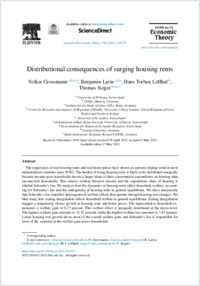Distributional consequences of surging housing rents
BP2-STS
- Grossmann, Volker ORCID University of Fribourg, CESifo, IZA, CReAM
- Larin, Benjamin University of St. Gallen, University of Zurich
- Loefflad, Hans Torben Leipzig University
- Steger, Thomas Leipzig University, CESifo, IWH
- 2021
Published in:
- Journal of Economic Theory. - Elsevier BV. - 2021, vol. 196, p. 105275
English
The trajectories of real housing rents and real house prices have shown an upward sloping trend in most industrialized countries since WW2. The burden of rising housing rents is likely to be distributed unequally because income-poor households devote a larger share of their consumption expenditures on housing than income-rich households. This inverse relation between income and the expenditure share of housing is labeled Schwabe's law. We analyze how the dynamics in housing rents affect household welfare, accounting for Schwabe's law and the endogeneity of housing rents in general equilibrium. We show analytically that Schwabe's law amplifies heterogeneous welfare effects that operate through housing rent changes. We then study how zoning deregulation affects household welfare in general equilibrium. Zoning deregulation triggers a temporarily slower growth in housing rents and house prices. The representative household experiences a welfare gain of 0.37 percent. This welfare effect is unequally distributed at the micro-level. The highest welfare gain amounts to 12.52 percent, while the highest welfare loss amounts to 1.63 percent. Lower housing rent growth drives most of the overall welfare gain, and Schwabe's law is responsible for most of the variation in the welfare gain across households.
- Faculty
- Faculté des sciences économiques et sociales et du management
- Department
- Département d'économie politique
- Language
-
- English
- Classification
- Economics
- License
- Rights reserved
- Open access status
- green
- Identifiers
-
- DOI 10.1016/j.jet.2021.105275
- ISSN 0022-0531
- Persistent URL
- https://folia.unifr.ch/unifr/documents/322924
Other files
Statistics
Document views: 55
File downloads:
- 1-s2.0-s0022053121000922-main.pdf: 209
- supplementarymaterial.pdf: 55

